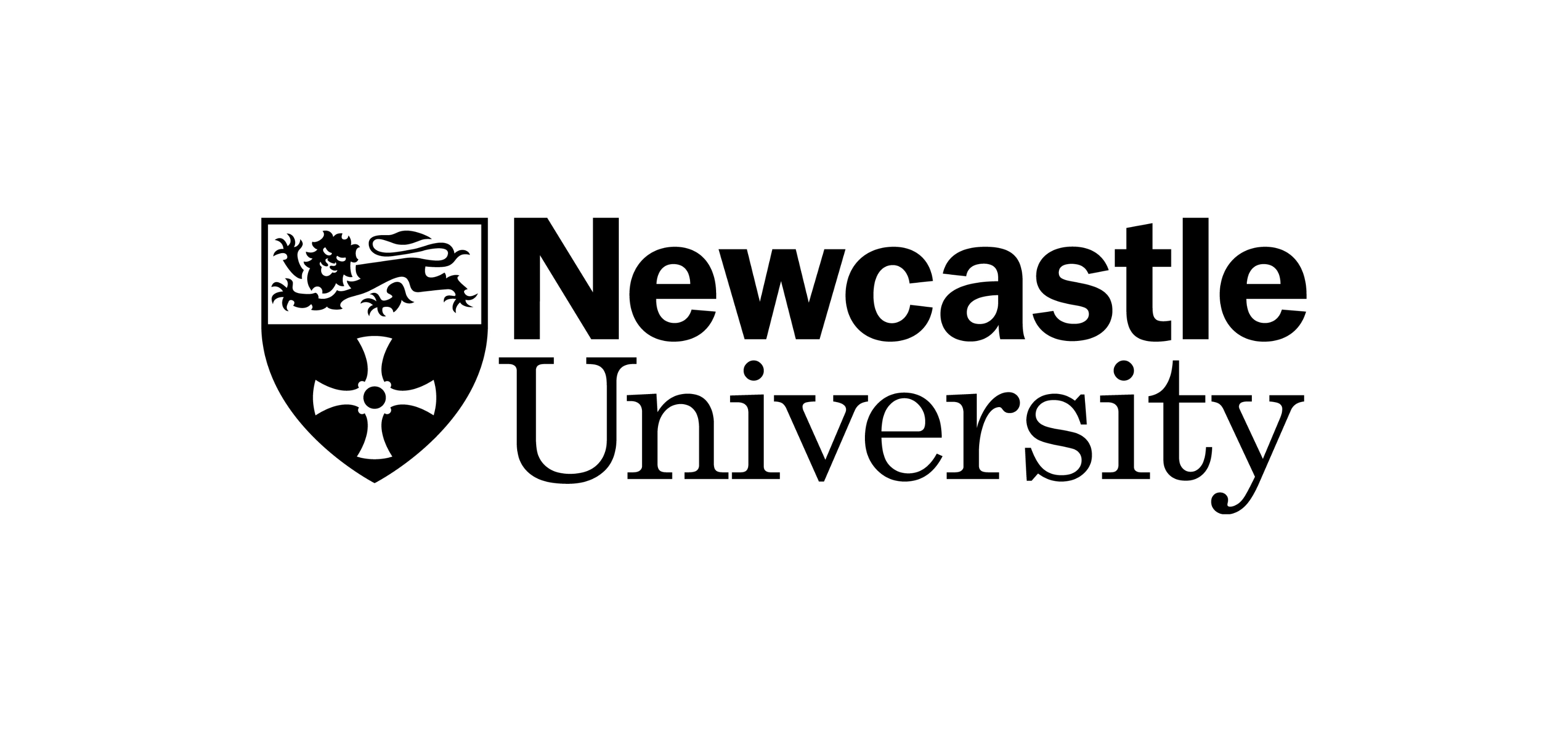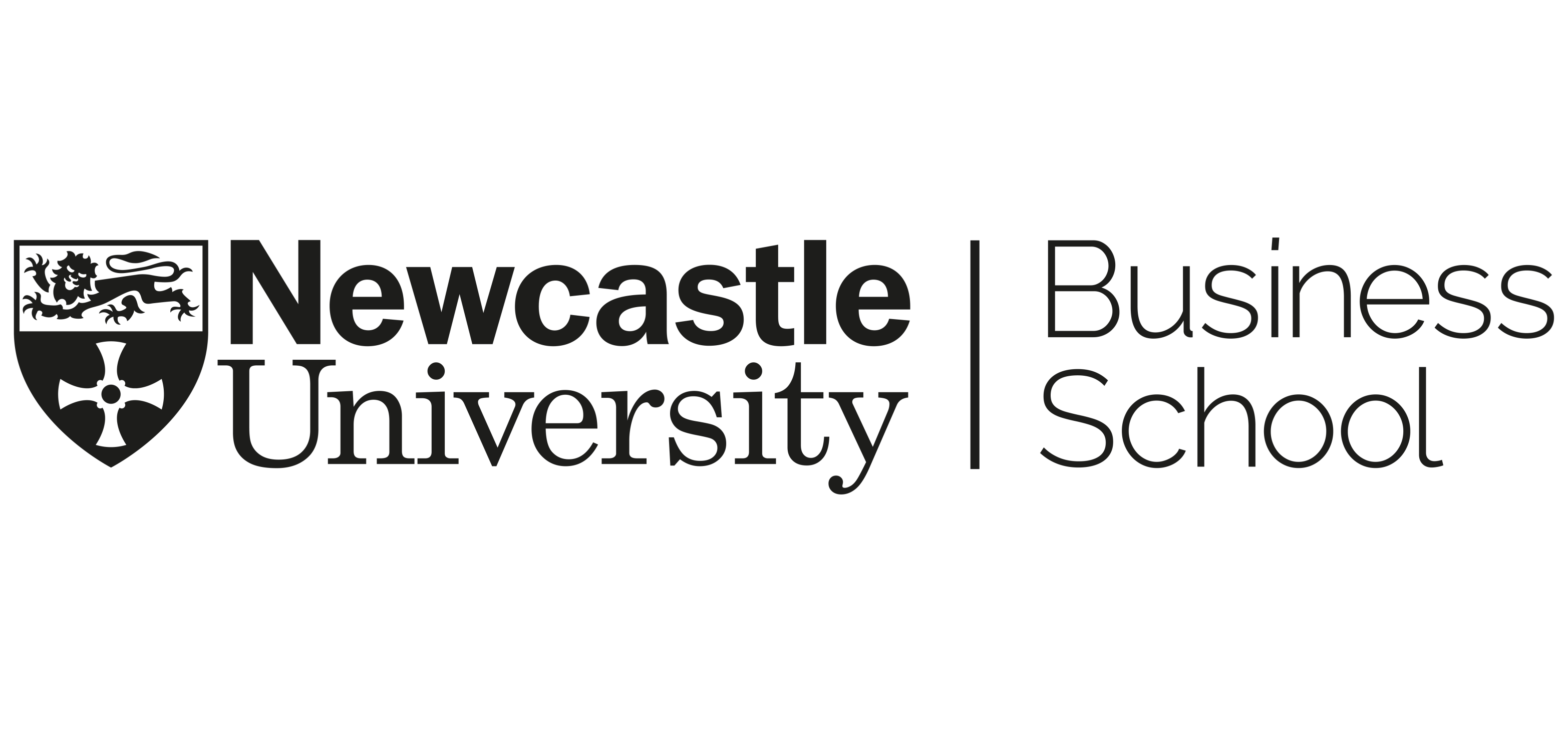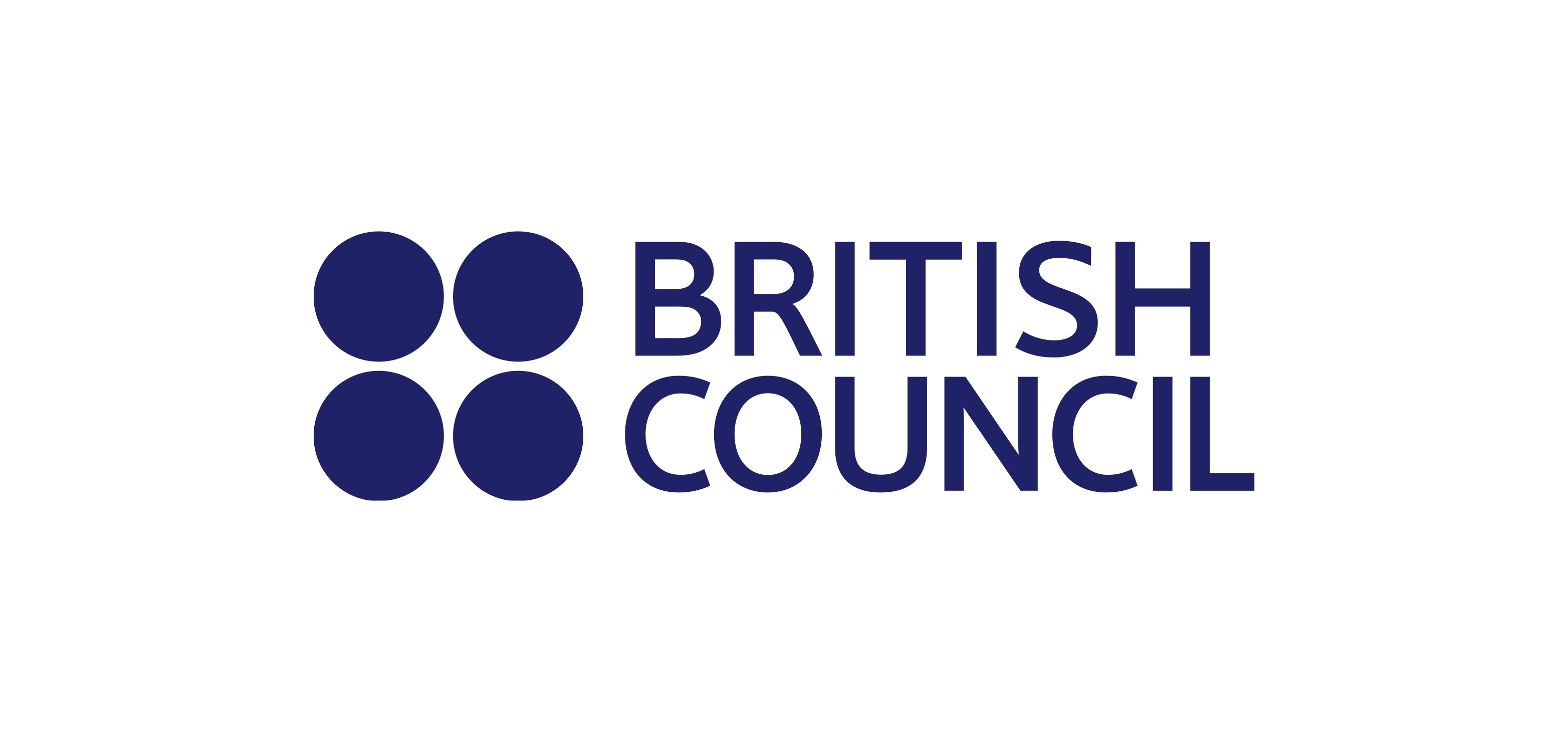Day 1 Sessions
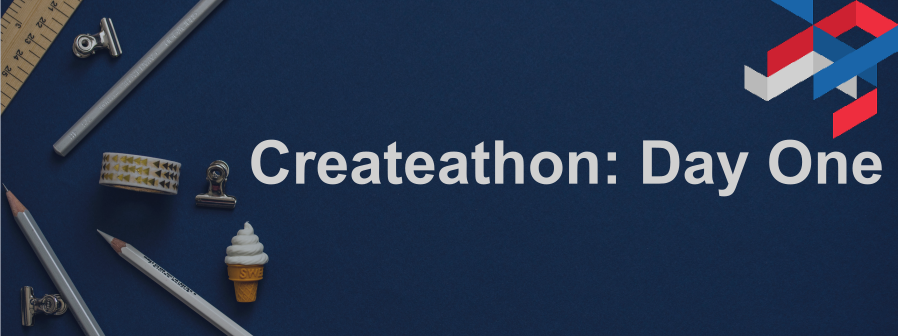
The workshop largely comprises practical activities, in which the teams are given specific tools to apply to tasks and the time to go into breakout spaces and work as a team. The student teams will be working directly with their creative enterprise. Your role as facilitator is to ensure energy levels remain high, that the teams are confident in taking on the activities, that you keep to time, and that this is a fun and valuable experience for all participants. There are six activities on Day One – this is a high-paced workshop – and your role is crucial. We go on to describe each activity in turn, interspersed with guidance for your facilitator tasks.
Createathon Day One and Two - an editable Word file for facilitators, where you'll find the details from all sections on this page.
Createathon: Day One and Two (for students) - an editable Word file.
Creativity Warm-Up Exercises
Action 1: The Creativity Warm Up – (30 mins)
Session Purpose:
It is important to build rapport as facilitators with the participants, especially when working online with students who you may have not met before. It is beneficial also to play some creativity games to help students relax and also demonstrate how creative they are by practicing generating ideas - ahead of working on their company challenges.
This is also an opportunity to introduce some of the theory around ‘the how to’ of ideation and also to give a context to innovation – incorporating a wide scope of ideas to improve products, processes and develop ideas for new services. It is also helpful at this stage to inform the students that your expectations are not limited to digital solutions to the enterprise challenges, as this can sometimes be a misconception when the event is online delivery and learning is remote.
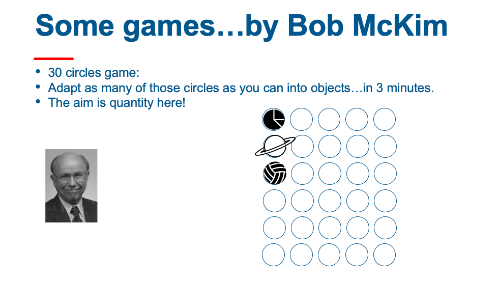
- Createathon - Creative Warm-Up PowerPoint presentation.
- Download a printable 30 circles game template.
The exercises outlined in the sample PowerPoint deck intentionally progresses individuals to working on their own to then begin working in their teams within their breakout spaces. This design is specifically to test that they are comfortable with the online platform you are utilising, and they can be. As facilitators, we enter their breakout spaces with ease form the plenary session.
Enterprise Storytelling
Activity 2: Enterprise Storytelling - (45 min)
Purpose:
This is an opportunity for the students to hear the story of their creative entrepreneur and their enterprise. While this could be in the form of a narrative from the entrepreneur, we recommend this in the form of a conversation led by the students. This way they gain insights into the motivation of the entrepreneur and a snapshot as to where the enterprise is presently, in relation to the challenge that they have scoped out ahead of the Createathon in the form of the Createathon Business Brief template.
Format:
Students ask questions to their entrepreneur to get the “story” of the business. Basic questions from students can be formulated under these key headings:
- Origin of the business and people involved in this business.
- Background of the founder of the creative enterprise.
- Significant incidents in the enterprise’s history.
- Product and/or services in the creative enterprise’s current portfolio.
- Current customer and revenue streams.
- The origin of the challenge set for the Createathon.
Personal Values Exercise
Activity 3: Value Exercise - (15 mins)

Purpose:
Students are going to capture and organise their client’s personal values. What makes them feel passionately committed to what they are doing in their business?
Format:
Students ask the entrepreneur to consider what is for them:
- Always important
- Sometimes important
- Rarely important
- Never important
Use the Miro Board Values Exercise template to let students synthesise their findings from conversations with their appointed entrepreneur:
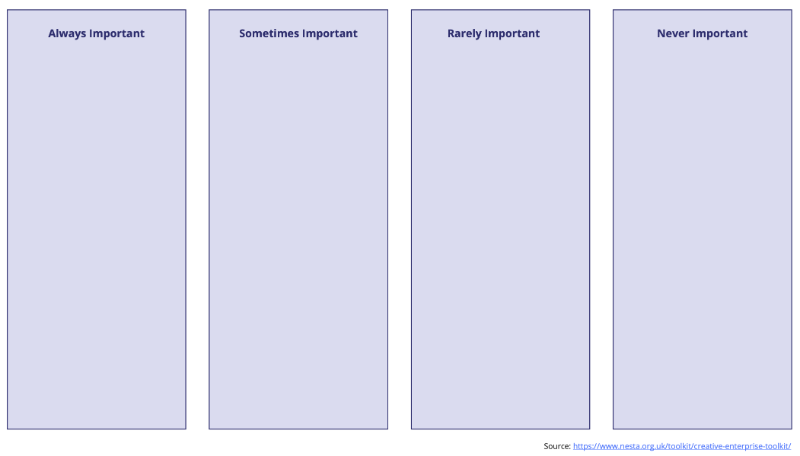
This activity originates from the NESTA: Creative Enterprise Toolkit. When working with owners of creative enterprises (indeed when working with any entrepreneur) it is important to recognise that their venture is a product of their passion and personal values. With creative enterprises the venture will also reflect the owner(s)’s own creative practice(s). It is vital for you to understand the personal values of the owner that underpin the enterprise so that you do not suggest any business direction or action that would go against those values.
NESTA provides a list of values that you could use as prompts for this task (full list available in Createathon Day One document):
Accountability, Achievement, Advancement, Aesthetics, Authority, Balance, Belonging, Celebrity, Challenge, Co-operation, Community, Creativity, Credibility, Curiosity...
Problem Statement Exercise
Activity 4: Creating a Problem Statement - (15min)
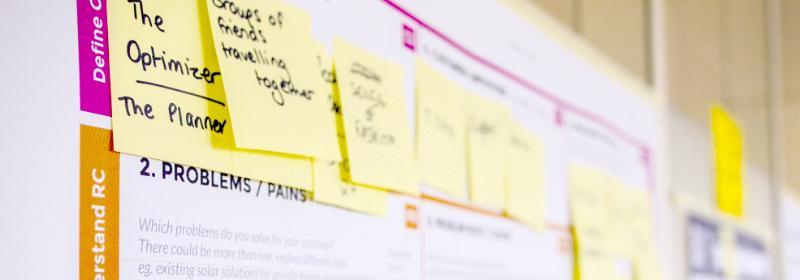
Purpose:
In this context, a problem statement is a way of describing the gap between where the creative enterprise is at present and where they want to be after the Createathon. The creative enterprise has established where they want to be through their challenge brief and through the storytelling exercise the teams have established where the creative enterprise is at present. Creating a problem statement aids analysis of the creative enterprise challenge and will help the team consolidate all assumptions and act as a touch point to test any potential solutions for the ongoing process of designing a solution for the company challenge. It is important to remember however that solutions are not proposed at this stage.
The benefits of a problem statement at the very beginning of the Createathon are:
- Touchpoint throughout the workshop process
- Communication tool for team to consolidate information from initial discussions with creative enterprise/entrepreneur
- Feedback prompt for plenary session
- Each team can share the problem statement on their Miro board.
Format:
- The problem of (describe the problem) ____________.
- Affects (who are affected by the problem) ____________.
- The impact of which is (what is the impact of the problem) ____________.
- A successful solution would (list some key benefits of a successful solution, ensuring that you have considered the personal values of your creative enterprise) ____________.
Creative Business Model Canvas
Facilitator Task: Introduction to the Creative Business Model Canvas (CBMC) - (15 mins)
Purpose:
The Business Model Canvas presents a visual overview of the 9 components of a business on one page and is:
- A strategic management and lean start-up template for developing new OR documenting existing business models.
- A visual chart with elements describing a firm’s value proposition, infrastructure, customers and finances.
- A tool to assist in testing and aligning business activities.
The (Creative) Business Model Canvas in this workshop is used as a tool to capture and develop the team’s design-led thinking and to iterate to build the final solution to be presented within the final presentation in Day Two. The facilitator should emphasise that because these are established creative enterprises much of the CBMC can be completed from the enterprise storytelling. The focus should be on the areas of the CBMC that have been highlighted in the problem statement.
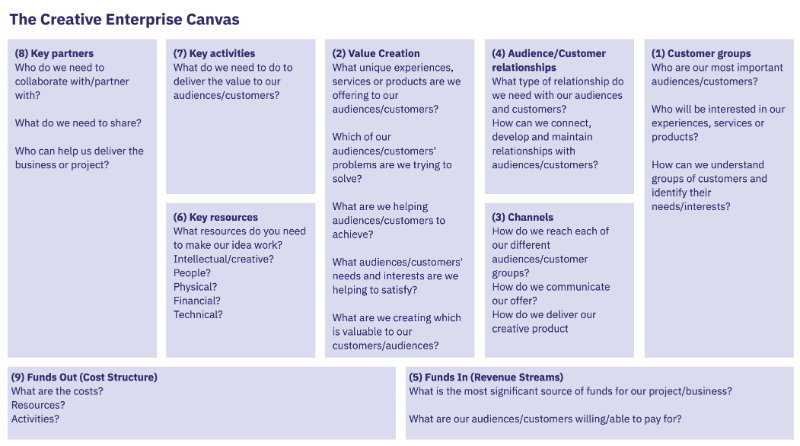 We provide a Business Model Canvas template on Miro, however, we have also created the Creative Enterprise Canvas for businesses specifically from the creative sector. Both contain numbered sections and questions to guide students in filling in the BMC.
We provide a Business Model Canvas template on Miro, however, we have also created the Creative Enterprise Canvas for businesses specifically from the creative sector. Both contain numbered sections and questions to guide students in filling in the BMC.
Activity 5: Completing relevant sections of the CBMC, depending on enterprise’s priorities - (60 mins)
Purpose:
The CBMC should be completed focusing on the sections relevant to the enterprise’s priorities.
Note: The main focus is on designing the value proposition in developing a solution to the enterprise challenge, so if the creative enterprise seems to be struggling to define the benefits they offer to their customers/clients then it could be useful to use the Value Proposition Canvas first (see below). Here we link to a very brief overview of the Value Proposition Canvas on YouTube.
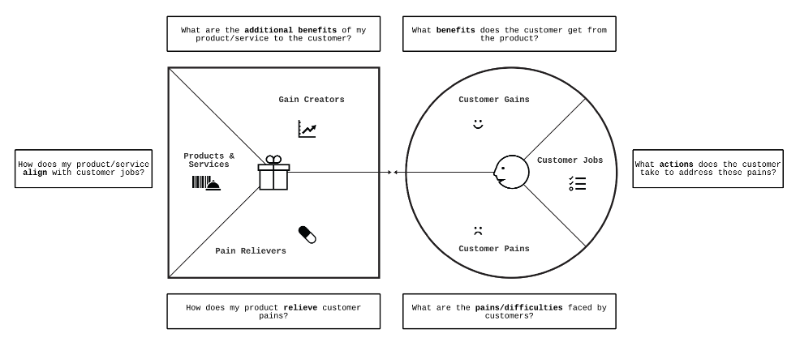
What Would Success Look Like?
Exploring what success looks like for the entrepreneur and their enterprise (30 mins)

Success in business means something different to each individual entrepreneur and exploring this topic with the students is essential so they can glean further insights into the specific createathon business challenge. It is also part of the information gathering stage, so the students can frame their recommendations to fit the entrepreneur’s vision of developing their enterprise.
Format:
Key areas for this discussion are the Entrepreneur’s Development Goals they are working towards; these can be personal or professional, for example:
- Generating a certain revenue amount
- Employing more people in the business,
- International travel alongside reaching a global marketplace,
- Leaving a legacy for their family,
- Or maybe being able to acquire materials good such as cars or property all while maintaining a certain lifestyle.
Sharing their current vision with the students can also benefit the entrepreneur’s plan for success.
Next Steps
Wrap up the event, by feeding forward the next action steps for day two (15 mins)

Task for Createathon: Day Two
As a homework task, students prepare their Pecha Kucha style presentation, in teams. In order to make it easier for them we have prepared these materials:
Additionally they can use these resources:
1. Leanne Robinson-Maine - Top Tips for Pecha Kucha Presenters
Preparing to present at a Pecha Kucha event? I've got you covered with my top tips for making your presentation soar.
2. Brian Scott Peterson, Pecha Kucha's Global Dude at PKHQ in Tokyo
He has watched literally 1000's of Pecha Kucha Presentations. He has given quite a few as well and thinks he knows, from lots of experience and a birds-eye view from headquarters what makes a truly great Pecha Kucha Presentation. Watch this presentation and more like it at https://www.pechakucha.com/presentati... (Links to an external site.)
3. Pecha Kucha about Pecha Kucha, by Hans Van de Water
A world without boring PowerPoint presentations? It is possible! In this video public speaking mentor, Hans Van de Water (The Floor is Yours) explains to you what Pecha Kucha is about and how it works. Do you want to know more?
4. Images
For images in the presentation, students can use Unsplash.com - a repository of copyright free images.
What should students know?
- Inform students of what support is available from facilitators before day 2 of Createathon. E.g. you could announce a schedule of seminar slots, to be booked by each team or have a drop in clinic for anyone to access on a more ad hoc basis, then not having to stay once they have their specific questions answered.
- Clarify how and the frequency the students can access their creative enterprises before day two of the Createathon. If this additional contact to work with entrepreneurs has not been defined at programme level, then this may need to be negotiated on a ‘case by case’ basis directly with the creative company. Each team could nominate a student to be in contact with the company, over their preferred mode of communication. Most popular is often email correspondence, as less intrusive then a phone call. However, all entrepreneurs situations are different and so agree how best to contact each other - is important. Enquires via email or text can be dealt with by the recipients at a convenient time. This will enable the student to get the help they need, in timely manner.
- Close session and thank all participants.
